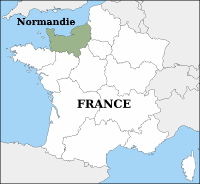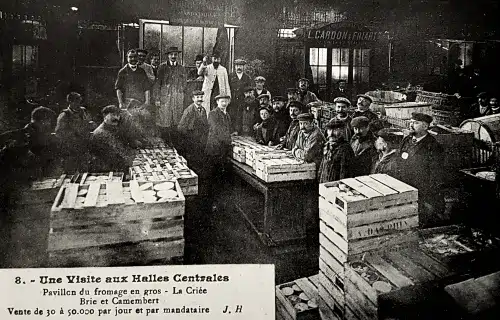
The Camembert is probably the most famous and the most popular French cheese
in the world. Its success was so important over the years, that it was exported
all over the world, and that it is now produced in various countries such
as Italy, Switzerland, Japan, USA, Brazil...
Even if one dislikes it, one can't deny the important part of that cheese in the cheese-making history. Unfortunately, it is generally unrecognized, and one knows a little about its story, its making or the best way to relish it.
The web and these pages will offer you an unique opportunity to make disappear that lack of knowledge.
And now for something completely different...
At the beginning was Normandy...

...its region and its famous cows, but for most of us the history of camembert began with a French farmer: Marie Harel. In the middle of the French Revolution (1791, if we trust the oral tradition), she gave birth to a delicious cheese, which was named according to the name of the town she was living in:
In fact, cheeses were produced in Camembert since at least 1680. For example,
Thomas Corneille (the brother of the famous French writer) wrote in 1708 in
his "General Geographic and Historical Dictionary", that every Monday
on the Vimoutiers market, you could buy excellent cheeses from the Camembert
area. Marie Harel had probably "just" improved the recipe, helped
by a non-juring priest (Abbey Bonvoust) that she was hiding since 1790, and
who gave her a secret about the preparation of cheese.

At the end of the XIXth century, railwails and steamboats spread all over Europe, which created new outlets for the camembert cheese in France and abroad.
The Camembert producers were obviously quickly interested by these new opportunities
but one problem remained: how to carry efficiently the camembert cheese...
In 1890 the French engineer Ridel created a wood
box to make this cheese carriage easier. Soon that simple and cheap
idea became used by all the camembert producers.
The success of the camembert in those days deeply changed the social organisation
of a large part of Normandy: "le pays d'Auge" (the Auge country).The
milk production became the first agricultural production and in the same time,
the rich farmers organized co-operative societies to collect milk from different
farms.
This evolution probably changed the taste of the camembert and gave it the
one we know today. At that moment, it also obtained its light yellow color.
The reputation of that cheese grew quickly and many other countries began
to produce their own "Camembert". The Norman notables were at first
quite happy of that unexpected success, but soon they became afraid of losing
precious consumers and of letting the taste of their cheese be modified and
its quality be lowered.Therefore they decided to create the "Syndicat
des Fabricants du Véritable Camembert de Normandie" (Genuine
Camembert of Normandy Makers Syndicate). It was inaugurated in 1909, by its
first president M. Vignoboule, who then defined precisely that was a Norman
camembert and how it should be made....
The great drama of camembert will be played a few years later ... While it acquired a certain reputation during the first world war (see page "Sidelights of Camembert history") more and more producers in France and abroad start to produce cheeses that they call "Camembert" (even when the only link between the two products seems to be a vague resemblance). The producers of Camembert Normand, who now perceive a danger in this recognition and who want to preserve their exclusivity on this product will therefore try to assert their rights on the legal ground.
Thus, in 1926, the rather ill-inspired Orléans court will declare on appeal that the Camembert name is not specific enough to constitute a protected mark, and that it has become generic ...
From this date, the Camembert name can therefore be used for all types of cheese and if subsequently with the red label then the AOC and the AOP, the Norman producers will try to restore the authenticity by creating the name "Camembert de Normandie", there will always be "two" camemberts, some confusion among consumers, and room for many abuses ...

